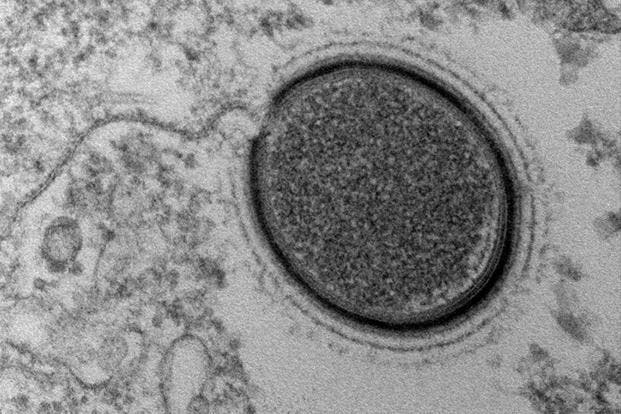French scientists announced the discovery of Mollivirus sibericum in the US National Academy of Sciences journal this week. The “Siberian soft virus” is the fourth pre-historic virus found since 2003, and the second one claimed by the team. They plan on reanimating the 30,000 year old giant virus unearthed from the frozen soil of Siberia for study, after verifying that it cannot cause human or animal disease.

A handout photo provided by the IGS-CNRS and Aix-Marseille University School of Medicine shows cells of the Mollivirussibericum. Image via livemint
But they warn that rising temperatures may awaken other dangerous pathogens in nature, not laboratory conditions. Climate change is warming the Arctic and sub-Arctic regions at more than twice the global average, which means that permafrost is neither as permanent or frosty any more.
“A few viral particles that are still infectious may be enough, in the presence of a vulnerable host, to revive potentially pathogenic viruses,” Jean-Michel Claverie, one of the lead researchers, told AFP.
To qualify as a “giant”, a virus has to be longer than half a micron, a thousandth of a millimetre (0.00002 of an inch). To put it into perspective, one of the largest modern viruses, Megavirus chilensis (also known as the megavirus), boasts a length of 0.4 microns. Mollivirus sibericum clocks in at a whopping 0.6 microns, a full 50 percent larger diameter.
The regions where these giant microbes have been found are highly coveted for their mineral resources, oil especially, and as the ices melt they become increasingly more accessible for industrial exploitation.
“If we are not careful, and we industrialise these areas without putting safeguards in place, we run the risk of one day waking up viruses such as small pox that we thought were eradicated,” he added.
The team will attempt to revive the newly discovered virus by placing it with single-cell amoeba, which will serve as its host, in safe laboratory conditions. Claverie, who runs a lab at France’s National Centre for Scientific Research (CNRS), and a team discovered another giant virus, which they called Pithovirus sibericum, at the same location in 2013, then managed to revive it in a petri dish.
It’s not the first time scientists have revived a virus. In 2004, US scientists resurrected the notorious “Spanish flu” virus, which killed tens of millions of people, in order to understand how the pathogen was so virulent. The researchers flew to Alaska to take frozen lung tissues from a woman who was buried in permafrost.By teasing genetic scraps out of these precious samples and from autopsy tissues stored in formalin, the team painstakingly reconstructed the virus’ genetic code in a top-security lab at the US Centers for Disease Control and Prevention (CDC).
Unlike most viruses circulating today, however, and to the general astonishment of scientists, these ancient specimens dating from the last Ice Age are not only bigger, but far more complex genetically. M. sibericum has more than 500 genes, while another family of giant virus discovered in 2003, Pandoravirus, has 2,500. The Influenza A virus, by contrast, has only eight.









